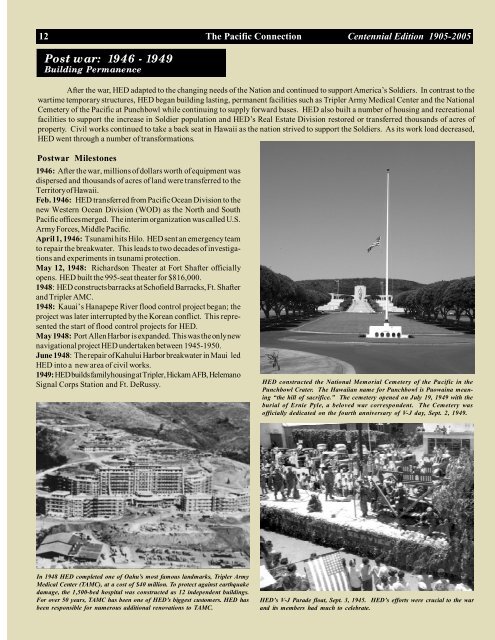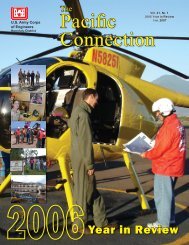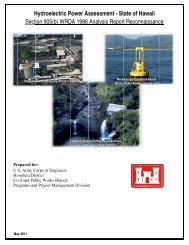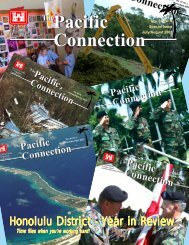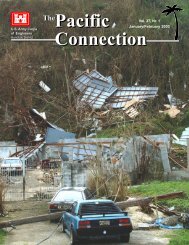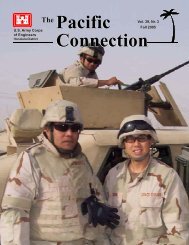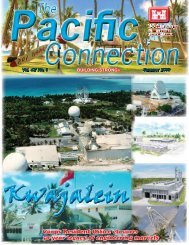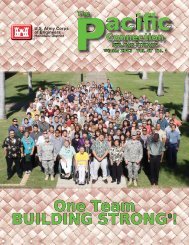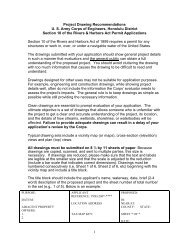The Pacific Connection - Honolulu District - U.S. Army
The Pacific Connection - Honolulu District - U.S. Army
The Pacific Connection - Honolulu District - U.S. Army
Create successful ePaper yourself
Turn your PDF publications into a flip-book with our unique Google optimized e-Paper software.
12 <strong>The</strong> <strong>Pacific</strong> <strong>Connection</strong> Centennial Edition 1905-2005Post war: 1946 - 1949Building PermanenceAfter the war, HED adapted to the changing needs of the Nation and continued to support America’s Soldiers. In contrast to thewartime temporary structures, HED began building lasting, permanent facilities such as Tripler <strong>Army</strong> Medical Center and the NationalCemetery of the <strong>Pacific</strong> at Punchbowl while continuing to supply forward bases. HED also built a number of housing and recreationalfacilities to support the increase in Soldier population and HED’s Real Estate Division restored or transferred thousands of acres ofproperty. Civil works continued to take a back seat in Hawaii as the nation strived to support the Soldiers. As its work load decreased,HED went through a number of transformations.Postwar Milestones1946: After the war, millions of dollars worth of equipment wasdispersed and thousands of acres of land were transferred to theTerritory of Hawaii.Feb. 1946: HED transferred from <strong>Pacific</strong> Ocean Division to thenew Western Ocean Division (WOD) as the North and South<strong>Pacific</strong> offices merged. <strong>The</strong> interim organization was called U.S.<strong>Army</strong> Forces, Middle <strong>Pacific</strong>.April 1, 1946: Tsunami hits Hilo. HED sent an emergency teamto repair the breakwater. This leads to two decades of investigationsand experiments in tsunami protection.May 12, 1948: Richardson <strong>The</strong>ater at Fort Shafter officiallyopens. HED built the 995-seat theater for $816,000.1948: HED constructs barracks at Schofield Barracks, Ft. Shafterand Tripler AMC.1948: Kauai’s Hanapepe River flood control project began; theproject was later interrupted by the Korean conflict. This representedthe start of flood control projects for HED.May 1948: Port Allen Harbor is expanded. This was the only newnavigational project HED undertaken between 1945-1950.June 1948: <strong>The</strong> repair of Kahului Harbor breakwater in Maui ledHED into a new area of civil works.1949: HED builds family housing at Tripler, Hickam AFB, HelemanoSignal Corps Station and Ft. DeRussy.HED constructed the National Memorial Cemetery of the <strong>Pacific</strong> in thePunchbowl Crater. <strong>The</strong> Hawaiian name for Punchbowl is Puowaina meaning“the hill of sacrifice.” <strong>The</strong> cemetery opened on July 19, 1949 with theburial of Ernie Pyle, a beloved war correspondent. <strong>The</strong> Cemetery wasofficially dedicated on the fourth anniversary of V-J day, Sept. 2, 1949.In 1948 HED completed one of Oahu’s most famous landmarks, Tripler <strong>Army</strong>Medical Center (TAMC), at a cost of $40 million. To protect against earthquakedamage, the 1,500-bed hospital was constructed as 12 independent buildings.For over 50 years, TAMC has been one of HED’s biggest customers. HED hasbeen responsible for numerous additional renovations to TAMC.HED’s V-J Parade float, Sept. 3, 1945. HED’s efforts were crucial to the warand its members had much to celebrate.


